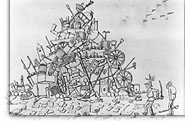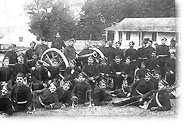Silent cannons
Lévis Forts National Historic Site
 Humoristic drawing of the British garrison's departure in 1871
Humoristic drawing of the British garrison's departure in 1871© Recollections of Canada / W.O. Carlisle & C.B. Martindale / 1873
Construction finally began on the detached forts just at the moment when the American threat tapered off. The risk of armed reprisals against Canada soon subsided. To put an end to its controversial quarrels with the Americans, London used its strongest arm: diplomacy. In 1871, negotiators signed the Treaty of Washington, while in Europe the conflict also subsided due to the English talent for mediation.
The strategy for the defence of Point Lévy, which involved heading off any invasion from the south, was no longer relevant. Great Britain left the government of Canada the task of protecting its own borders. In accordance with the dictates of the Empire's military strategy, Québec's role was taken over by Halifax. British troops finally left the Québec region for good on November 11, 1871.
 Picture of the soldiers from the B Battery at the militia camp in 1897
Picture of the soldiers from the B Battery at the militia camp in 1897© National Archives of Québec / P585, P162
Thus, these three forts, built at such great cost, would never house a garrison and would never fire a shot in war. They were soon to become practice grounds for the artillery school (Battery B) of the Canadian Army, whose headquarters were in the Citadel at Québec.
Since Canada no longer had to worry about conflict with its neighbours to the south and since the Canadian Army was faced with budget cuts, the forts were not armed until 1878. In that year, Great Britain feared that the expansion of Russia towards Turkey and India would have repercussions in the colonies. Canada was poorly equipped in terms of armament and modern facilities to face such attacks using battleships.
 Armstrong-type rifled cannon
Armstrong-type rifled cannonIn the end, the Russian threat did not materialize, but it did force the Canadian government to rethink its defence strategy to include the possibility of a naval offensive from overseas. This climate of tension made them fear possible raids and naval bombardments on Canadian ports. So in reaction to the Russian threat, each fort received a piece of breach-load rifled artillery of approximately 17 cm. This Armstrong cannon was the only piece of artillery ever to be mounted on the terreplein at Fort No. 1. It was able to fire a 40-kg shell over a distance of 5 km.
From Warehouse to National Historic Site
 Fort No. 1, before restoration
Fort No. 1, before restoration© Public Works
According to a testimony, Fort No. 1 once served as a munitions warehouse and barracks for troops waiting to be sent to Europe in World War I. It continued as a munitions warehouse between the two wars and into World War II.
Despite the fact that the fort was never used to its full potential, it nonetheless has great historical interest. As an integral part of the defence complex of Québec, it bears witness to the evolution in fortification techniques and marks the transition from classical to modern military art, from the concept of the continuous rampart to the detached fort.
From an architectural standpoint, the quality and beauty of the work are admirable. The underground passageways, the caponiers vaulted in brick, the stairs in the gorge caponier perched over corbels, are just some of the architectural features sure to interest visitors.
Under the leadership of Mr. Paul Théberge, a group of volunteers called Les Compagnons du vieux fort (Friends of the Old Fort) put a great deal of energy into saving the fort in the 1960s. In 1972, a century after the construction of the fort, Parks Canada undertook the sizeable task of stabilizing and restoring the fort. Since 1982, the site has been open to the public every summer.
- Date modified :